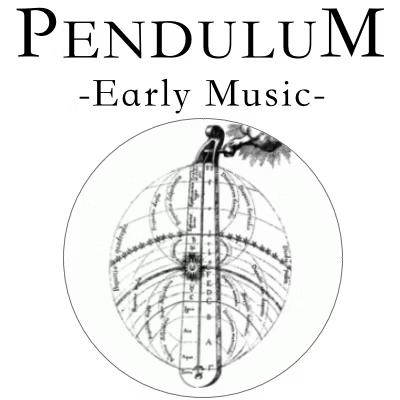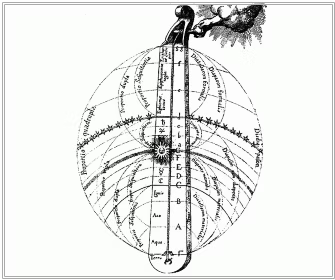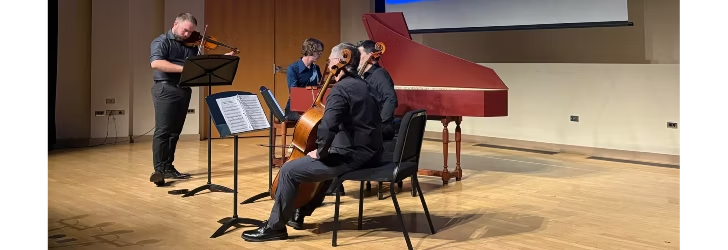
Pendulum Early Music is a group based in Boise, Idaho, dedicated to historically-informed performance of music from the 16th-18th centuries.


The Baroque period (1580–1750) can be divided into early, middle, and late phases, each with its own unique contributions. The early Baroque (1580–1650) saw the birth of opera, the rise of expressive solo singing, and a move away from the complex polyphony of the Renaissance. Composers like Claudio Monteverdi and Heinrich Schütz were pioneers of this era, using new forms to create emotionally compelling works.
In the middle and late Baroque periods (1650–1750), music became more structured and elaborate, with the development of forms like the concerto, sonata, and fugue. Composers such as Johann Sebastian Bach, George Frideric Handel, and Antonio Vivaldi perfected these styles, producing some of the most enduring music in the Western canon. The early Classical period (1730–1770) then emerged, favoring clarity, balance, and simpler textures, with composers like Carl Philipp Emanuel Bach and early Wolfgang Amadeus Mozart leading the way. Together, these eras shaped the future of Western music.
The Baroque and early Classical periods featured a variety of instruments, many of which differ from their modern counterparts in both construction and sound. String instruments such as the violin, viola, cello, and double bass were played with gut strings, producing a warmer, softer tone compared to the metal strings used today. The bows of this period were also different—Baroque bows were shorter and had a convex shape, allowing for lighter, more articulated playing, especially suited to the dance rhythms and expressive phrasing of Baroque music.
The harpsichord and organ were central to providing harmonic support, often playing basso continuo lines, while the fortepiano emerged in the early Classical era as a precursor to the modern piano, offering a greater dynamic range than the harpsichord.
Woodwinds like the recorder, baroque flute (without modern keys), oboe, and bassoon had simpler designs, often lacking the complex key mechanisms seen in modern instruments. Brass instruments, such as the natural trumpet and horn, had no valves, meaning players had to manipulate their embouchure and hand placement to change pitch, making them more challenging to play.
Plucked instruments like the lute and theorbo were widely used in the Baroque era but gradually faded in popularity by the Classical period. These historical instruments, along with period-specific bows, give early music its distinctive texture and sound, quite different from modern orchestral performances.
The Baroque and early Classical periods were shaped by a remarkable group of composers whose innovations set the foundation for much of Western classical music. In the early Baroque (1580–1650), Claudio Monteverdi pioneered the use of expressive vocal lines and instrumental accompaniment, laying the groundwork for opera. Heinrich Schütz brought the Italian style to German music, merging it with the rich choral traditions of the time.
As the Baroque progressed, composers such as Johann Sebastian Bach, Antonio Vivaldi, and George Frideric Handel became iconic figures. Bach’s mastery of counterpoint, Vivaldi’s virtuosic concertos, and Handel’s dramatic oratorios represent the height of late Baroque composition (1650–1750). Each composer left an enduring legacy, not only in the works they wrote but in the musical forms they helped shape, such as the concerto, fugue, and cantata.
The early Classical period (1730–1770) saw a shift toward simplicity and clarity, with composers like Carl Philipp Emanuel Bach and Christoph Willibald Gluck breaking away from Baroque complexity in favor of elegant, structured forms. These composers paved the way for later Classical giants like Wolfgang Amadeus Mozart and Franz Joseph Haydn, whose early works still bear the influence of Baroque traditions.
Performance during the Baroque and early Classical periods differed significantly from modern approaches, with an emphasis on improvisation, ornamentation, and historical techniques. Musicians of the Baroque era were expected to add ornaments—such as trills, turns, and appoggiaturas—spontaneously, especially in vocal and instrumental solos. Composers often left room for these embellishments, allowing performers to express their creativity within the framework of the composition.
Another key aspect of Baroque performance was the use of basso continuo, where a keyboard or plucked instrument (like a harpsichord or lute) provided harmonic support based on a figured bass line. The continuo player had flexibility in how to realize these harmonies, often improvising the accompaniment in real time.
Tuning systems also varied, with "unequal" temperaments being common. Instruments were often tuned in ways that favored certain keys, giving them distinct color and character. Additionally, historical performance often involved a lower pitch standard than what is used today (A = 415 Hz, compared to the modern A = 440 Hz).
In the early Classical period, performance began to shift toward more structured dynamics and articulation, though improvisation still played a role, particularly in cadenzas. Understanding these historical practices allows modern performers to recreate the authentic sound and spirit of early music.
The development of Baroque and early Classical music was deeply influenced by the cultural, political, and social settings of the time. In the Baroque period (1580–1750), Europe was experiencing dramatic shifts, including the rise of absolute monarchies, the Catholic Counter-Reformation, and the growing influence of the middle class. Music played a central role in both religious and secular life, with composers often working under royal patronage, creating elaborate works for courtly events, ceremonies, and celebrations. Kings, such as Louis XIV of France, were great patrons of the arts, commissioning large-scale operas, ballets, and instrumental music to display their power and prestige.
Churches were also significant centers of musical activity. In Catholic countries, music was used to inspire devotion, with grand choral works and intricate instrumental music often accompanying the Mass. In Protestant regions, such as Germany, sacred music, including chorales and cantatas, became prominent, particularly through the works of Johann Sebastian Bach, who composed for both liturgical and civic occasions.
Public performance venues began to emerge in the late Baroque and early Classical periods, allowing wider audiences to experience music outside of the court and church. Opera houses, particularly in Italy, flourished, as opera became a popular art form. The early Classical period (1730–1770) marked a shift toward public concerts and a growing demand for music among the middle class, leading composers to write for broader audiences. The rise of the public concert hall democratized music, setting the stage for the widespread accessibility of classical music in the centuries to come.
The Baroque and early Classical periods produced a wealth of music that remains influential and beloved today. Some of the most iconic works of the Baroque era include Johann Sebastian Bach’s Brandenburg Concertos (1721), which showcase the composer’s mastery of instrumental writing and complex counterpoint. Bach’s Mass in B Minor and The Well-Tempered Clavier are also regarded as pinnacles of Baroque composition, combining intricate structure with deep emotional expression.
Antonio Vivaldi’s The Four Seasons (1725) is another defining work of the period, vividly depicting the changing seasons through virtuosic violin writing and programmatic elements. George Frideric Handel’s Messiah (1741) is among the most famous oratorios, celebrated for its powerful choral writing, including the renowned "Hallelujah" chorus.
In the early Classical period, Carl Philipp Emanuel Bach’s Keyboard Sonatas (c. 1740s–1770s) were highly influential, introducing expressive contrasts and emotional depth that laid the groundwork for later Classical composers. Christoph Willibald Gluck’s Orfeo ed Euridice (1762) reformed opera by simplifying its structure and focusing on drama and emotion, setting the stage for future operatic development. The early symphonies of Franz Joseph Haydn and the youthful works of Wolfgang Amadeus Mozart, such as Symphony No. 1 (1764), also signal the transition from Baroque complexity to Classical elegance and balance.
These works exemplify the artistic innovation and lasting appeal of early music, representing a rich legacy of musical creativity.
The Baroque and early Classical periods saw the development and evolution of many musical forms that became foundational to Western classical music. One of the most intricate forms of the Baroque era is the fugue, a highly structured composition in which a single theme is introduced and then developed through complex counterpoint. Johann Sebastian Bach’s The Art of Fugue is a prime example of this form, showcasing the Baroque fascination with elaborate, interwoven melodies.
The concerto also flourished in the Baroque period, typically featuring a contrast between a solo instrument or small group of instruments (the concertino) and a larger ensemble (the ripieno). Antonio Vivaldi’s The Four Seasons exemplifies the solo concerto form, where a violinist takes center stage against the backdrop of a string orchestra. As the Classical period emerged, the concerto evolved to feature greater dialogue between the soloist and orchestra, as seen in the piano concertos of Wolfgang Amadeus Mozart.
The sonata became an important form during both the Baroque and Classical periods, though its structure evolved significantly. In the Baroque period, sonatas were typically multi-movement works for one or more instruments, such as Arcangelo Corelli’s Sonatas for Violin and Continuo. By the Classical period, the sonata-allegro form became more standardized, with three distinct sections: exposition, development, and recapitulation, offering composers like Mozart and Haydn a framework for their instrumental compositions.
Another significant Baroque form was the suite, a collection of dance-inspired movements, often in the same key but differing in tempo and character. Johann Sebastian Bach’s Orchestral Suites are notable examples, featuring movements like the allemande, courante, and gigue, each rooted in popular dances of the time. By the Classical period, the suite form gave way to more standardized structures like the symphony, though elements of the suite persisted in other forms.
These forms and genres not only shaped the music of their time but also laid the groundwork for the developments of the Classical era and beyond, influencing the structure and composition of Western classical music for centuries.
The innovations of the Baroque and early Classical periods had a profound influence on the development of Western music in the centuries that followed. Baroque composers, particularly Johann Sebastian Bach, laid the groundwork for the art of counterpoint, a technique that would inspire composers well into the Romantic era. Ludwig van Beethoven, for example, studied Bach’s works extensively and incorporated complex counterpoint into his late string quartets and symphonies.
The concerto form, which emerged during the Baroque era, continued to evolve through the Classical and Romantic periods. Wolfgang Amadeus Mozart expanded the dialogue between soloist and orchestra, and Frédéric Chopin and Johannes Brahms later took the concerto to new heights, building on the virtuosic foundations established by composers like Antonio Vivaldi.
Baroque performance practices, such as basso continuo and improvisation, found renewed interest in the 20th century through the early music revival movement. Musicians like Pablo Casals and conductors like Nikolaus Harnoncourt reintroduced historically informed performance techniques, which influenced the way modern performers approach not only Baroque music but also later works with more authenticity and historical awareness.
The emotional expressiveness and structured forms of early Classical music, developed by composers like Carl Philipp Emanuel Bach and Christoph Willibald Gluck, directly influenced later Classical composers such as Franz Joseph Haydn and Wolfgang Amadeus Mozart, who in turn shaped the music of the Romantic era. The sonata-allegro form, popularized in the early Classical period, became the blueprint for the symphonies and chamber music of Ludwig van Beethoven and Franz Schubert.
The legacy of early music continues to be felt, as modern composers and performers alike draw inspiration from the clarity, balance, and emotional depth found in Baroque and early Classical works, ensuring their lasting relevance.
© 2024-2025 Pendulum Early Music Ensemble | Powered by ![]()
Being part of Boise's arts and cultural scene, as both a performer and educator, is an incredibly rewarding part of my life. Since 2012, I have been part of that scene, when I won my position as Principal Second Violin of the Boise Philharmonic. Since then, a regular performing schedule has shaped me into the musician I am today.
Before coming to Boise, I grew up in Portland, OR, where an environment of friendly competition among young musicians instilled in me a drive to make music my lifelong pursuit. That drive led me to the College of Idaho in 2008, where I studied with violinist Geoffrey Trabichoff and other members of the Langroise Trio to hone my skills for the professional world.
Though I came from Oregon, and before that, Ohio, Idaho is really now my home. My wife Kate, also a violinist, and I love cooking, trying new restaurants in Boise's increasingly cosmopolitan scene, and spending time in the beautiful Idaho outdoors (or just our backyard) with our corgi pup, Finlay.
Cellist Brian Hodges performs on modern, Baroque cello and viola da gamba. He is the author of A Survey of Solo Works for the Violoncello: A guide to 200 selected pieces from the literature from 1689-2023, and the co-author of Cello Secrets: Over 100 Performance Strategies for the Advanced Cellist, and contributes regularly to The Strad and Stringsmagazines.
With his wife, pianist Betsi Hodges, he has given recitals across the US, Canada and Italy. They have premiered works by noted composers such as Lee Hoiby, David Biedenbender, Mark Olivieri, Carolyn Steinberg and were featured on a recording of the works of composer David H. Johnson. He has appeared as soloist with the Jackson Symphony Orchestra, the Boise Baroque Orchestra, the Boise State University Orchestra, and was the featured soloist with the Tuacahn Performing Arts High School Orchestra on their tour in Seattle. He has performed at the Idaho Bach Festival and was a featured guest artist at the 2011 Elizabeth Cowling Cello Festival in Greensboro, NC. In 2022, he was a featured artist on the American Bach Society's series Tiny Bach Concerts.
Brian is the principal cellist of the Boise Baroque Orchestra and performs regularly with Classical Revolution: Boise, which has been featured at the Idaho Shakespeare Festival and performed live on Radio Boise. He is a founding member of the Rothko Piano Trio, with Betsi Hodges on piano, and Jo Nardolillo on violin, which has performed nationwide and has commissioned several new works.
Originally from San Antonio, Texas, he soloed with the San Antonio Symphony as a winner of the Young Artists Competition. He went on to study at the Eastman School of Music earning his Bachelor of Music degree in cello performance and stayed on to complete his Master of Music degree in cello performance where he was the teaching assistant to Marcy Rosen. While at Eastman, he was the founding member of the Genesis String Quartet, which had several residencies in the U.S., including Roberts Wesleyan College and a rural residency in Madisonville, KY, where they performed for over 10,000 schoolchildren. He received his Doctor of Musical Arts in cello performance from the University of North Carolina at Greensboro where he was a member of the graduate piano trio in residence. Throughout his schooling, he participated in master classes with such cellists as Bernard Greenhouse, Steven Doane, Gary Hoffman, Nathaniel Rosen, and Jeanne Lamon of Tafelmusik.
Brian is currently Professor of Cello and Coordinator of Chamber Music at Boise State University in Boise, Idaho. Before joining the faculty at BSU, he was on the faculties of the Townsend School of Music at Mercer University in Georgia, Spring Arbor University and Albion College and served as co-director of the Jackson Symphony String Academy in Jackson, MI. At UNCG, he was the administrative assistant for the Luigi Silva Centennial Cello Celebration and the Bernard Greenhouse Cello Celebration and performed at both festivals. He has given presentations at national American String Teachers Association conferences, as well as other regional and state conferences.
During the summers, he performs and teaches at the Idaho Orchestra Institute, and has been on the faculty at Fairbanks Summer Arts Festival in Alaska, the Green Valley Chamber Music Festival in Las Vegas, the Redlodge Music Festival in Montana, the Summer Music Institute in San Antonio, TX, and the String Camp of Rochester. As a student, he attended such festivals as Aspen, Interlochen, Roundtop, the Quartet Program at Bucknell University, the Heidelberg Castle Opera Festival in Heidelberg, Germany, the Thy International Chamber Music Festival in Denmark, the Hampden-Sydney Chamber Music Festival in Virginia and the Banff Centre for the Arts in Banff, Canada.
As a chamber musician, he has appeared as guest cellist with the Penderecki String Quartet, performed with the Kandinsky Piano Trio, the Chimera Duo, and has been coached by members of the Cleveland Quartet, Shanghai Quartet, Amadeus Quartet, Ying Quartet, St. Lawrence Quartet, Brentano Quartet, Beaux Arts Trio, and the Guild Piano Trio.
His teachers and mentors have included Brooks Whitehouse, Pamela Frame, Alan Harris, Marcy Rosen, Mary Ruth Leonard, Paul Katz, Ron Leonard, and Eleanor Schoenfeld. He has studied viola da gamba and early music with Ann-Marie Morgan, Christel Thielmann, Paul O'Dette, Mark Cudek, Catherina Meints, Ken Slowik and Rebecca Landell Reed.
Kevin McTeague performs on both modern and baroque cello, but mostly baroque! He is a “late returner” to the cello, having studied cello at the Oberlin Conservatory in the late 70’s and then quitting music to study public administration at the University of Oregon. During his two years at Oberlin he studied modern cello with Andor Toth, Jr. of the New Hungarian String Quartet and chamber music with Richard Young and Denes Koromzay, also of the New Hungarian Quartet.
Following a 30 year career in administration of homeless, low-income health care and victim service programs, he took early retirement in 2015 and resumed studying the cello with Sam Smith. In the past four years he has focused exclusively on historical performance practice. He has attended the Oberlin Baroque Performance Institute, Amherst Early Music Baroque Academy and the Tafelmusik Baroque Academy. He has performed in masterclasses for Kenneth Slowick (Smithsonian Chamber Players), Phoebe Carrai (Julliard School), Cathy Meints (Oberlin Conservatory), Elinor Frey (McGill University), and Kieran Campbell (Tafelmusik Baroque Orchestra). Kevin is currently a student of Elinor Frey and performs on a 2023 Baroque Cello by Timothy Johnson.